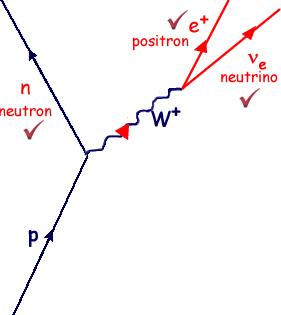Particle Questions that include Feynman Diagrams
Q1.
(a)
(i) What class of particle is represented by the combination of three antiquarks ?
Antibaryon 

(Saying 'baryon' got you only one mark, as did saying 'hadron')
(ii) Name a hadron that has an antiparticle identical to itself.
πo 
(3 marks)
(b) The kaon K+ has a strangeness of +1.
(i) Give its quark composition.
us 

(ii) The K+ may decay via the process  . State the interaction responsible for this decay. weak interaction
. State the interaction responsible for this decay. weak interaction 
(iii) The K+ may also decay via the process  . Change each particle in this equation to its corresponding antiparticle in order to complete an allowed decay process for the negative kaon K–
. Change each particle in this equation to its corresponding antiparticle in order to complete an allowed decay process for the negative kaon K–


(iv) Into what class of particle can both the μ+ and the νμ be placed? lepton 
(v) State one difference between a positive muon, μ+, and a positron, e+.
mass or rest energy or stability
(6 marks)
(c) The diagram below shows a partially completed Feynman diagram of β- decay. Complete the diagram and label all the particles involved.

(3 marks)
(Total 12 marks)







